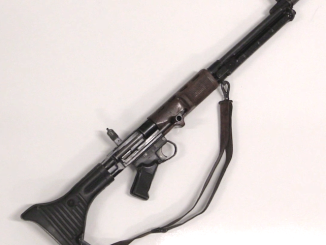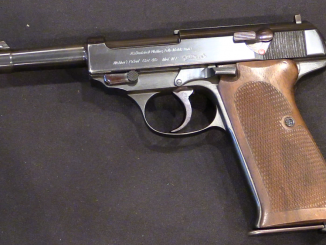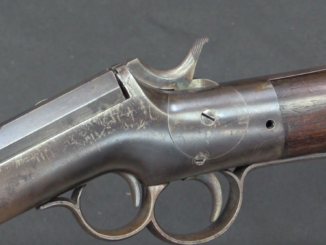The H&K Mk 23 pistol was developed in the 1990s for the US Special Operations Command and US Navy. The goal was to produce an “offensive handgun” that could serve as a primary armament for a special forces operator as well as a backup arm. It was required to be no more than 12 inches long, fit a suppressor and aiming module with laser and illumination options in both visible and IR spectrum, have at least 10-round magazines, chamber .45 ACP (specifically a 185gr +P loading), and pass a 30,000 round endurance test.
Only two companies were able to supply acceptable initial pistols; H&K and Colt. The Colt pistol failed to pass the 1st phase testing. H&K presented a gun based on the recently-developed USP design, was ultimately chosen as the project winner; adopted as the Mk 23 pistol in 1996. The testing this pistol went through during development is really quire remarkable!




These are interesting pistols.. They’re great as a collectable, not really that practable. I don’t think many were actually used..It’s my understanding that many of these things are still in storage. The reason being they’re too big.In his book No Easy Day author Mark Owens discribes the two pistols they used, on pg45 of his book, a HK45c, and a Sig P226, the .45c makes sense..it’s small, accurate,reliable, set up to run suppressors, can take 10 rnd mags. Basically does everything a MK23 can do, in a smaller package. If you have to carry everything you need with you, a smaller lighter pistol that does a equally good of a job makes sense, after all, the misson you’re going on is going to decide the gear you’re going to need.
“Too big”…? For who? When was the last time anybody whined about a 1911 .45 “Long-slide” pistol (a .45ACP pistol with a 6″ bbl and slide for added velocity) pistol as being “too long”…?? You’re also forgetting another important fact about the gun: a steel-framed 1911 with a standard (“service-sized”) 5″ bbl & slide, empty, weighs 42oz. The Mk 23, empty, weighs in at 39oz. Not so “huge” anymore, is it..?? Now take an HK .45 or HK .45 Tactical pistol and a Mk 23, and field-strip both of them, line them up side by side, and examine carefully the “innards” of both guns. You’ll quickly notice the “beefier” parts in the Mk 23 compared to the HK .45/Tactical pistol. The gun was designed to shoot thousands of rounds with no failures. When did you ever see a Sig or anything else “go that distance”…?? The point is, at close range, sure, a Sig or a 1911 or an HK .45 will do the job. Hell, at ultra-close ranges, a Walther PPK in .32 will “do the job”. It all depends upon what you reasonably expect from the gun you’re carrying. Go back & reread the last sentence you wrote. With handguns as in most everything else in life, “one size fits all” seldom works. “Smaller & lighter” ain’t always “the solution”.
After Ian’s thorough Mk23 explanation – mystery dispelled 🙂 Well done!
This weapon would actually pass easily as carbine due to its size and other attached modules. Little of surprize is that HK did not employ their patented roller lock instead of vague and potentially detrimental (due to large and heavy muffler) tilt-barrel style. The credit has to be given to innovative application of Viton (my guess based on color) O-ring to help to stabilize barrel.
Yeah, and the Mark 23 looks cool in the hands of movie heroes. I’m certain that the intended victims were guard dogs and sentries, both of whom must be silenced before they can see or smell your presence. And the overly heavy but accurate and suppressed pistol works great in areas where you can’t bring a rifle or carbine to bear (like inside a building). The whole point of this sneaking: don’t get caught! You may laugh at me for thinking about Metal Gear Solid…
..… movie heroes… right.
I’d even say – Actors. And in fact even military lingo is full of “theatrical” terms. I wonder if main “actors” (grunts) are aware of this 🙂
… they often play their last role in “theatre” of battle (how to do sad face?)
“I suppose you won’t be satisfied until I play dead.”
“Your next performance, in fact. I’m sure you won’t disappoint us.”
[THUNK!]
“A carbine due to its size…”?? What’ve you been smoking, anyway..?? It has a 1″ longer barrel & slide than the HK .45. That makes it a “carbine”..? Spoken like a person who doesn’t know what the hell he’s talking about. The gun, empty, weighs 39oz. The std. 1911 .45, empty, weighs in at 42oz. Gee… doesn’t seem so “huge” anymore, huh..?? I carry one, concealed, with no problems. Hmmmmm… Maybe I should start carrying an OA-93, 5.56NATO caliber “pistol”, huh…??
You don’t carry one concealed, nor do you own one. Those of us that do realize it has a place but concealed carry is not part of it. Keep dreaming about the day you get your hands on one. Not surprisingly you mentioned an OA-93, which you are probably impressed with. Something tells me you are impressed with KelTec’s and Taurus as well.
I think it’s a sufficient commentary on the MK23 that the SEALS, for whom it was initially developed as a successor to the MK22 “Hush Puppy” S&W 9mm, ended up with the MP5-PDW with the side-folding stock, the Navy trigger group with 3-shot burst control, the ability to mount a suppressor, and the ability to reliably cycle 147-grain subsonic 9 x 19mm loads.
The MK23s, meanwhile, remained in storage.
Also, considering that the MK23 weighs 2.29 kg (5 lbs) fully loaded with all the gadgetry attached up front and a 12-round magazine, and the MP5K-PDW with all the bits plus a 30-round magazine only weighs 3.2 kg (7.75 lbs), the rationale for the MK23 becomes even more difficult to explain, especially as at the time the U.S. military was converting from .45 ACP to 9 x 19mm across the boards in the pistol-caliber weapon department.
Incidentally, I have used both the MK23 and the police type USP .45. Neither one particularly impressed me. I believe their main virtues were that (1) their 1911-type safety appealed to 1911 fans, and (2) otherwise, they just looked mean.
cheers
eon
“(…)SEALS(…)MK23(…)remained in storage(…)”
Wait, so they invested in development of very specific automatic pistol to conform to their very specific requirements, acquired batch and… rather do not use them?
If so, following question: who was responsible for development and acceptance of these requirements?
Socom. It was a joint program. (Horse designed by committee, or in this case gun.)
“rationale for the MK23 becomes even more difficult to explain, especially as at the time the U.S. military was converting from .45 ACP to 9 x 19mm”
I found caliber decision understandable taking in account it was to be often used suppressor.
I think the point here is that regular .45 ACP is subsonic, so it won’t require “dialing down” of powder charge to suppress easily. Otherwise the bullet might “bounce” off target (when I say “bounce,” I mean “percussive injury without penetration,” which usually does not result in immediate death but instead lots of cursing and sounding of alarms). Yes, you may laugh now.
H and K – because you suck and we hate you.
Larry Correia’s take on the MK 23 (and other H und K products, and the fanboys who idolize them-http://monsterhunternation.com/2007/10/09/hk-because-you-suck-and-we-hate-you/
I will always cherish the memory of the time an H und K flogger tried to sweet-talk my agency into the then brand-new MP-5 in 1980, and I proceeded to outshoot him and it on everything from accuracy out to 100 meters (he insisted on meters, not yards!), to penetration on “bullet-proof” vests- with a surplus M1 carbine, cal. 30 USC.
And back then, you could buy about four brand-new Ithaca-built Carbines for what H und K wanted for one MP-5.
Oh yes, I shot a PSG-1 once upon a time, too, with H und K approved ammunition. An accurized M21 that had been brought back from Vietnam, and looked it, consistently shot smaller groups with the same ammunition, or anything else for that matter. And didn’t destroy the brass, either.
I carried a .45 USP on duty for a while because it was “approved” by the chain of command and my old 1911 no longer was (because the 1911 required Condition One carry). Not only was it indifferently accurate and had a lousy trigger (not as bad as a S&W Sigma, but close), but things inside it rattled. Der H Und K Guy said that was normal.
I thought the idea of a “rattling” weapon that might blow a covert/dynamic entry was dumb, and said so. He just looked at me like I’d impugned the Host.
Then we officially went to 9 x 19mm, I ended up with a Beretta M92FS- but that’s another story.
Sign me “Not An H Und K Fanboy, And Never Have Been”.
cheers
eon
I’m not an HK diehard- my “G3” is a PTR- but I’m having a hard time believing your claims. 1) The MP5 was not new in 1980; it was introduced in 1965. New for law enforcement, perhaps. 2) That must have been one souped-up Carbine or a shot-out MP5, because M1 Carbines are 2-3 MOA guns on a good day, and I’ve seen the tiny groups MP5’s can put on target. You can lament the cost of one all day, but want of accuracy is not a problem for which they suffer.
That said,I’m with you on their pistols: I’ve tried to like them, but shooting them drives me right back to my Glock and Hi Power.
1. Back in ’65, the MP-5 was called the HK 54, and was purely military issue. It begann to come into law enforcement use in the U.S. in the mid 1970s; the first versions showed up, still with the straight magazine rather than the later and more reliable) curved one, in late 1974. Here in OH, it was Franklin Co. Sheriff’s SWAT that first adopted the MP-5, in 1978. Columbus PD, by comparison, stuck with the M1 carbine.
2. The MP-5 is pretty accurate out to about 50 meters due to the closed-bolt firing cycle. At 100 meters, the drop on U.S spec 9 x 19mm (124 gr. at 1,050 at the time) was sufficient to adversely affect the accuracy, because the sights were regulated for European milspec 9mm (usually 124 gr. at 1,250).
The carbine, in good condition, should shoot into 2″ at 100 yards, 6″ at 200, and 10″ to 12″ at 300, where velocity is down by about 40% and energy is about equal to a .45 ACP or 9 x 19mm at the muzzle of an SMG. Not target grade, but good enough for the job.
3. All I know is that I and three other shooters, two of them ex-Army, one an ex-sniper (it was his M21) all shot better with the M21. And of the four of us, three were familiar with the standard H&K 91 model, including me.
Yes, the PSG is more accurate than the “regular” 91; the M21 is still probably a bit more accurate than it is.
I’ve heard it said that the FAL can’t really be brought up to sniper-grade accuracy. Having never had more than a passing acquaintance with it, I’ll leave that question to anyone who knows it better.
cheers
eon
The MP5 was introduced in ’65, but it didn’t get its big break until 1980, when they became an instant icon in the hands of the SAS team that ended the Iranian Embassy siege. Prior to that, there was a lot more variety in “tactical” SMGs. 1st SFOD-D used Walther MPLs during Eagle Claw, SEALs in Vietnam were fond of Carl Gustav M/45s (the “Swedish K”) and Ingram M10s, Brits had the Sterling…and of course there were always Uzis kicking around.
I’m with you, if there was a table with a MP5 and a M1/M2 carbine on it and I had to use one or the other to clean out a building. I’d personally grab the carbine. I’ve many times tried to justify the purchase of a 9mm carbine to go along with the pistols I own, but why when I own a M1carbine that has way better penetration and better range? As far as the HK USP goes it has the ergonomics of a piece of thick sliced ham for me. So I guess I’m not much of a fan boy either. I think their mostly sold on prestige of the brand name.
Given it’s operational history and widespread usage
here and abroad it seems odd to slag the MP-5. But I’ve never fired one or even picked one up so my observations are only academic.
The answer to your confusion is simple: HK has a FANTASTIC marketing department, and doesn’t build bad guns. Is the hype worth the additional Teutonic Space Magic markup on price? Probably not, in most cases.
Thus endeth the lesson.
Oh, and I have fired the MP5, various HK rifles and pistols, and a slew of different SMGs and short carbines. There is literally nothing an MP5 can do that an M4 cannot do better, except if you’re talking about the MP5K, because you need a PDW suitable for a holster on a normal human being. The 3-6″ difference between an M4 (depending on stock length) and an full size MP5 is irrelevant. and the M4 has better performance.
But the HKs look cool, and were featured in all the biggest action movies of the 1980s…
I have a Mark 23 and I find it not large at all. It’s not small, but it’s not uncomfortable and I wear a size L glove but I have skinny fingers. I guess it’s all in personal preference. I find it enjoyable to shoot.
I don’t know about other Mark 23’s but mine has a nice characteristic. When the slide is back after the last round if you push an empty magazine in it the slide remains but if you push in a full magazine, not too hard but with a decent amount of force, the slide will go forward and load the first round without having to trip the release. I always wondered if that was by design or just a convenient coincidence.
Better make your slide stop checked by a competent gunsmith. This is a common fault encountered in early production HK plastic frame hammer pistols.
“…parkerized and painted with black [locomotive] lacquer…” Very interesting.
Anyone ever see ceramic coating or other non-conventional (and non-reflective) finish used on a “cost-is-little-object” firearm?
An excellent walkthrough on the MK23, Ian. There is an additional functionality of that double recoil spring arrangement you didn’t mention though and it’s supposed to contribute significantly to the longevity and reliability of the SOCOM pistol. The small spring’s function is to initially decelerate the tilting action of the barrel. The slamming of the barrel is reduced by allowing the control surfaces that are pulling it down to reciprocate a few millimeters while the barrel is being unlocked from the ejection port. The unlocking surface isn’t static and located in the frame, it is on the recoil spring guide and the oblong cutout allows it to slide back along the slide stop/takedown pin. So the small spring compresses twice during recoil – first on unlocking – decelerating the barrel and second time when it buffers the slide as it reaches its rearmost position.
but where do i get one of these here socoms